←Return to Chapter 3: Writing and Selling My First Book
(A reminder that I’ve included links throughout the text for more information on people, places, and things mentioned in case something piques your interest.)
When I left off I was riding high on the publication of my first book Irresistible? in February 1997. It's hard to believe that as of this writing, that was over 27 years ago.
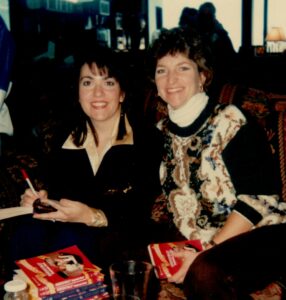
Me and friend Nancy McKenzie at a booksigning for my first book at Joseph-Beth Booksellers in Lexington, Kentucky
As I mentioned, my publisher recently reverted the rights to Irresistible?, which gave me the chance to update the story, both the writing and the cultural and technology references. Also, I decided to experiment with dropping small images into the text of story to enhance certain scenes. For example, here's a picture of the heroine's cat:
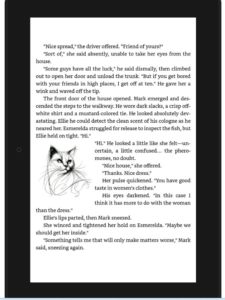
One of the images imbedded in the updated version of Irresistible?
If you read the updated version, please let me know what you think about having imbedded images… do you like them, or are they distracting? Your feedback will help me to decide whether to include imbedded images as I revamp more early titles.
If you're reading this chapter the day it drops, the updated and fully revamped version of Irresistible? is available now in ebook, exclusively from Amazon and available to subscribers of Kindle Unlimited (KU) from March 15, 2024 through June 15, 2024. After that date, I'll remove it from KU, but leave it on Amazon, and add it to all the other major book retailers: Barnes&Noble, Kobo, Apple Books, and Google Play. Irresistible? is also available in print!
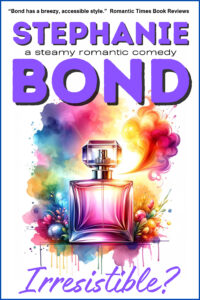
Click here to buy or download a sample of Irresistible?
But back to my story…
I mentioned in the previous chapter that while I was waiting for Irresistible? to be published, I sold a couple of other manuscripts. To recap, I sold Irresistible? to Harlequin Enterprises, which at that time, released most of their titles in lines known as category romances. Each book is released under the "brand" of a category, such as Harlequin Intrigue or, in the case of my first book, Love & Laughter.
The upside of selling to category romance lines is that the audience is already established—that's a huge leg up for a new author. The downside is the advances paid are on the small side, and when I first sold to Harlequin, authors didn't receive royalty payments until maybe a year after the book was published. Remember, I sold the book in December of 1995, but it wasn't published until February 1997. My goal was to be a full-time writer, but that meant replacing all or most of my income from my corporate job. In order to do that, I realized I was going to have to get several books in the publishing pipeline. But I was in a catch-22 position with Harlequin; a publisher is understandably reluctant to extend another contract to an author until they see how a first book performs, and the Love & Laughter line hadn't yet launched. My editor Brenda Chin seemed keen to buy another book from me, but her hands were tied.
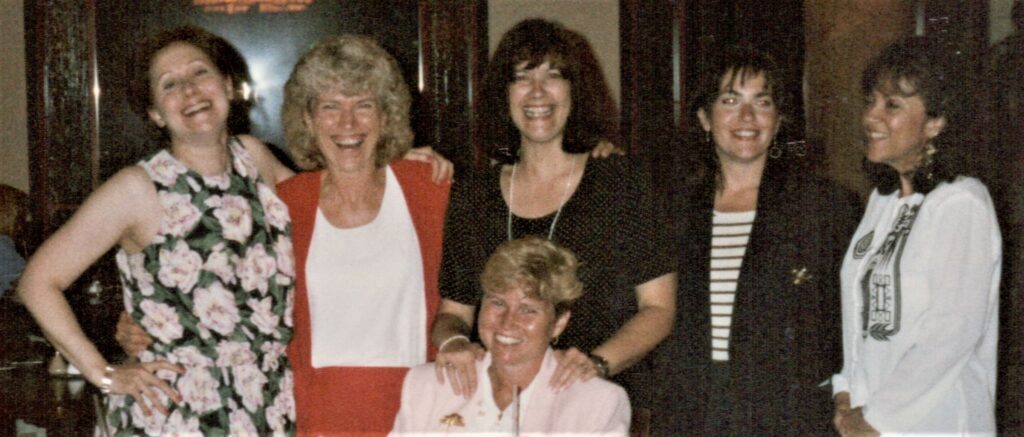
Some of the authors for the Harlequin Love & Laughter line:
L to R, standing: Bonnie Tucker, Vicki Lewis Thompson, Cheryl Anne Porter, me, Debbi Rawlins
Seated: Our editor Brenda Chin
So my agent suggested that we approach a rival publisher of category romances, Bantam Loveswept. When she contacted editor Shauna Summers at Loveswept, Shauna said my name rang a bell. It just so happened that she had a copy of a Georgia Romance Writers newsletter on her desk and had read a humorous "letter" I'd written to an anonymous editor about rejecting their rejection. It was a tongue-in-check response to every form rejection I and my writing friends had ever received. Shauna thought it was funny and mentioned she was attending a conference near Atlanta that I would also be attending. She arranged to meet me there.
In preparation for the meeting, I read as many Loveswepts as I could get my hands on to get an idea of the kind of story I should pitch. Loveswepts were short books like Harlequin's category romances (60,000 words, about 250 manuscript pages), but the books released each month ran the gamut from rom com to mystery to family drama.
At the conference, Shauna and I hit it off. She asked what I was writing for Harlequin and suggested that I submit something different for Loveswept. When I returned to Atlanta, I brainstormed a story about a couple who'd gotten married when they were young because of an unplanned pregnancy, then the infant had been kidnapped from a grocery store and their marriage hadn't survived the trauma. The story opened ten years later when their son is found—alive—and the couple has to reunite to co-parent. I submitted the proposal under the title Almost a Family, and Shauna bought it for the Loveswept line. I wrote the manuscript quickly and the book was given a publication date of March 1997, only one month after Irresistible?
At the time a clause in my Harlequin contract prevented me from writing for a competitor using the same name, so I had to choose a pen name for my Loveswept book. I stayed with Stephanie and for a surname I wanted to use something close to "Bond" so I chose "Bancroft."
Note: Harlequin's contract no longer requires an author to write under a different name for a competing publisher. If an author writes the same type of book for different publishers, the author will typically use the same name to create synergy. But there are business reasons for writing under different names:
At the time I sold my first book to Loveswept, Bantam had moved from illustrated "clench" covers that depicted a couple in an embrace to "hero covers" with the photograph of a man, a floral background and the title plus the author's name in a similar font. It was a move to set the books apart, and I was pleased to get a handsome man on my cover. (In hindsight, he resembles a young Al Gore!) But the hero covers were short-lived and later when I got the rights back, I chose a cover for the updated version of Almost a Family that reflected the storyline.
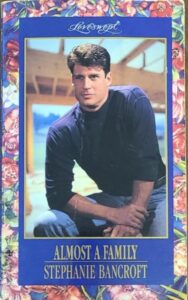
The original cover of ALMOST A FAMILY
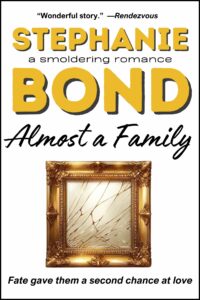
The cover for the updated version of ALMOST A FAMILY
Almost a Family is perhaps the only book I've written that isn't a comedy, and I really love the characters. If you missed Almost a Family, it's available in ebook, print, and audio, plus in German! Click here for links to your favorite online bookstores.
On a personal note, I'd like to mention that I dedicated Almost a Family to my beloved Aunt Fonda who brought me bags of romance novels to read when I was young. Fonda knew I'd sold my first romance novels, but sadly, she passed away before my first books were published.
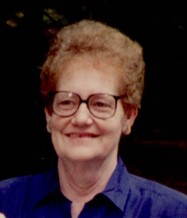
Fonda Sue Bond, who spread her love of reading to others, including me
After I sold the first couple of manuscripts, I arranged with my employer to go part-time as an independent contract programmer in order to have more time to write. After some experimentation with my schedule, I realized I was better off to sit-out the infamous Atlanta morning commute and work at home writing until noon, then drive to the office to work afternoons. For the next year, my workday was split evenly between writing and my corporate job, and I also spent many weekends writing.
When I sold the book to Bantam, my editor at Harlequin was given the greenlight to buy more books from me, and I sold more books to Bantam as well. Since I'd delivered complete manuscripts, now I was in a position to sell books on proposals and synopses.
Note: A synopsis is a 1-3 page description of a book, including information about the characters, the setup, how the story unfolds, and how it concludes. I'm always amused when aspiring writers tell me they can't write a story if they know how it ends. In order to sell a book to a traditional publisher, you have to prove you know how the story will end!
Now with ten sales under my belt to two publishers, I felt (somewhat) comfortable to give notice to my employer of my last day. I tied up loose ends to the projects I had underway and on July 11, 1997, said my goodbyes to coworkers. I'd spent ten years with the same company, and was now taking the big, huge, giant, colossal leap from being a corporate employee with a secure income and benefits to being a full-time novelist with no security and no benefits.
I hoped it would work out… but I truly didn't know. ~
→Go to Chapter 5: Writing Full Time, Sink or Swim